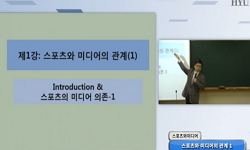조선후기사회의 신분구성비 변화는 상천 하층신분의 상승이동으로 인해 19세기 이전까지는 노비수의 급감과 양반호의 증가 현상으로, 19세기 이후부터는 양반호의 급증 현상으로 나타났다. ...
http://chineseinput.net/에서 pinyin(병음)방식으로 중국어를 변환할 수 있습니다.
변환된 중국어를 복사하여 사용하시면 됩니다.
- 中文 을 입력하시려면 zhongwen을 입력하시고 space를누르시면됩니다.
- 北京 을 입력하시려면 beijing을 입력하시고 space를 누르시면 됩니다.
18,19세기 농민층 분화와 '향촌중인(鄕村中人)'_프리프린트
한글로보기https://www.riss.kr/link?id=G3805310
- 저자
- 발행기관
-
발행연도
2005년
-
작성언어
Korean
-
주제어
농민층분화 ; 신분구성비 ; 중인 ; 향촌중인 ; 상중하계 ; 上中下契 ; 중계 ; 中契 ; 부계 ; 副契 ; 납속지류 ; 納粟之類 ; 이리동약 ; 二里洞約 ; Peasants`differentiation ; The component ratio of status ; The middle Class ; Three grades `kye` association ; The middle `kye` association ; The secondary `kye` association ; The middle classes by `Nabsok` ; The `Yi-ri` village rules
-
자료형태
한국연구재단(NRF)
-
0
상세조회 -
0
다운로드
부가정보
국문 초록 (Abstract)
조선후기사회의 신분구성비 변화는 상천 하층신분의 상승이동으로 인해 19세기 이전까지는 노비수의 급감과 양반호의 증가 현상으로, 19세기 이후부터는 양반호의 급증 현상으로 나타났다. 양반직역을 획득한 상민들 대다수는 직접생산자인 농민으로서, 이들에 의해 직역에 따른 혜택과 특권의 일정 부분만 누리는 반상의 중간층이 형성된다. 이러한 현상은 농민층의 분해나 양극화가 아닌 농민층 자체 분화의 결과다.
이 글의 목적은 18세기 이후 신분이동 현상과 관련하여 반상의 중간층을 형성해 간 농민층의 존재와 사회적 위상, 그리고 그 추이를 밝히는 것이다. 이들은 서얼층, 이서층, 또는 기술직을 지칭했던 기존의 中人과 구별되는 새로운 중간층으로서의 鄕村中人이다.
향촌중인은 18세기 이후에 현상화하는 존재들로서 주로 納粟을 통해 직역을 상승시킨 상민들이다. 『千一錄』의 저자인 취석실 우하영은 중인이라는 것이 신분 구분을 흐리게 하며 또 다른 부류의 중인을 등장시키는 등 신분상승의 여지를 제공한다고 하였다. 또한 중인들이 한두 번 거처를 옮기면서 그 계통을 숨기고 양반벌족으로 假託하면 사족과 구별할 수 없는 지경에 이르는데 세상에서는 이를 오히려 잘한 일로 평가한다고 개탄하였다. 다산 정약용 역시 양반이 되려는 상민층의 편법 중에 ‘離鄕遠徙’, 즉 고향을 떠나 멀리 이사 가는 현상을 들고 있다. 거주지 이동을 통해 실질적으로는 중인이라는 중간적인, 또는 그 이상의 위치를 향하여 신분상승을 꾀하는 자들이 하나의 사회현상으로 나타난 것이다.
지역공동체를 기반으로 한 향촌의 계 조직은 18세기 초까지는 거의가 양반의 上契와 상천민의 下契로 구성되어 있었다. 하지만 18세기 중반 이후로는 집단 개념이 부여된 하나의 실체로서 향촌중인들이 등장하고 향촌에서는 이를 받아들여 上下契에서 中契가 추가된 上中下契가 나타난다.
이 글은 이상과 같이 직역상으로 幼學이나 嘉善大夫 등의 품직을 얻어 신분상승한 상민들이 실제 향촌에서는 어떠한 신분적 지위에 있었는가에 주목한 결과 일반 상민과는 다른 대우를 받으면서 양반과는 구분되는 소위 중인이라는 새로운 중간층의 지위를 점하는 데에 이르렀음을 알게 되었다.
다국어 초록 (Multilingual Abstract)
The tendency in component ratio of status in late Chosun Dynasty was the gradual upward movement of some lower classes before the 19th, and sudden rise of that tendency after the 19th century. The greater part of them were peasants, but they have rece...
The tendency in component ratio of status in late Chosun Dynasty was the gradual upward movement of some lower classes before the 19th, and sudden rise of that tendency after the 19th century. The greater part of them were peasants, but they have received some or little favors from individually upward status. Such phenomena were the results of differentiation aspects in peasant class.
The purpose of this paper is to research and follow up the such peasants` social status and their changing class position in relation to the upward tendency after the 18th century. They are different from the existing middle class, such as lower official servant, craft man, etc. Additionally, they resided at ‘鄕村’, that is, villages in country side. So, I defined them as `鄕村中人‘, the middle class resided at villages in country.
They received favors from upward class by `Nabsok`(納粟), that is, by offering publically admitted bribes. Uh ha-yung, the late 18th century intelligentsia, said that such kinds of group threw class system into confusion, but general agreement was give to such wrong actions. An easier method among them was shifting or changing residence. Because new residence was free from one’s past career.
The new appearance of the three grades `kye` association(上中下契) in the late 18th century is related to such differentiation phenomena. That is, in addition to the existing two grades `kye` association(上下契), the middle `kye` association(中契) or the secondary `kye` association(副契) came into being, and the main constituents of that association were the new middle class peasants. I found the typical case in the `Yi-ri` village rules(二里洞約) at Kyunggi province.
국문 초록 (Abstract)
Ⅰ. 머리말 Ⅱ. 班常의 중간층 ‘鄕村中人’ Ⅲ. 上下合契에서 上中下契로의 分化와 ‘鄕村中人’ Ⅳ. 신분사에 있어서 ‘鄕村中人’의 의미
Ⅰ. 머리말
Ⅱ. 班常의 중간층 ‘鄕村中人’
Ⅲ. 上下合契에서 上中下契로의 分化와 ‘鄕村中人’
Ⅳ. 신분사에 있어서 ‘鄕村中人’의 의미








